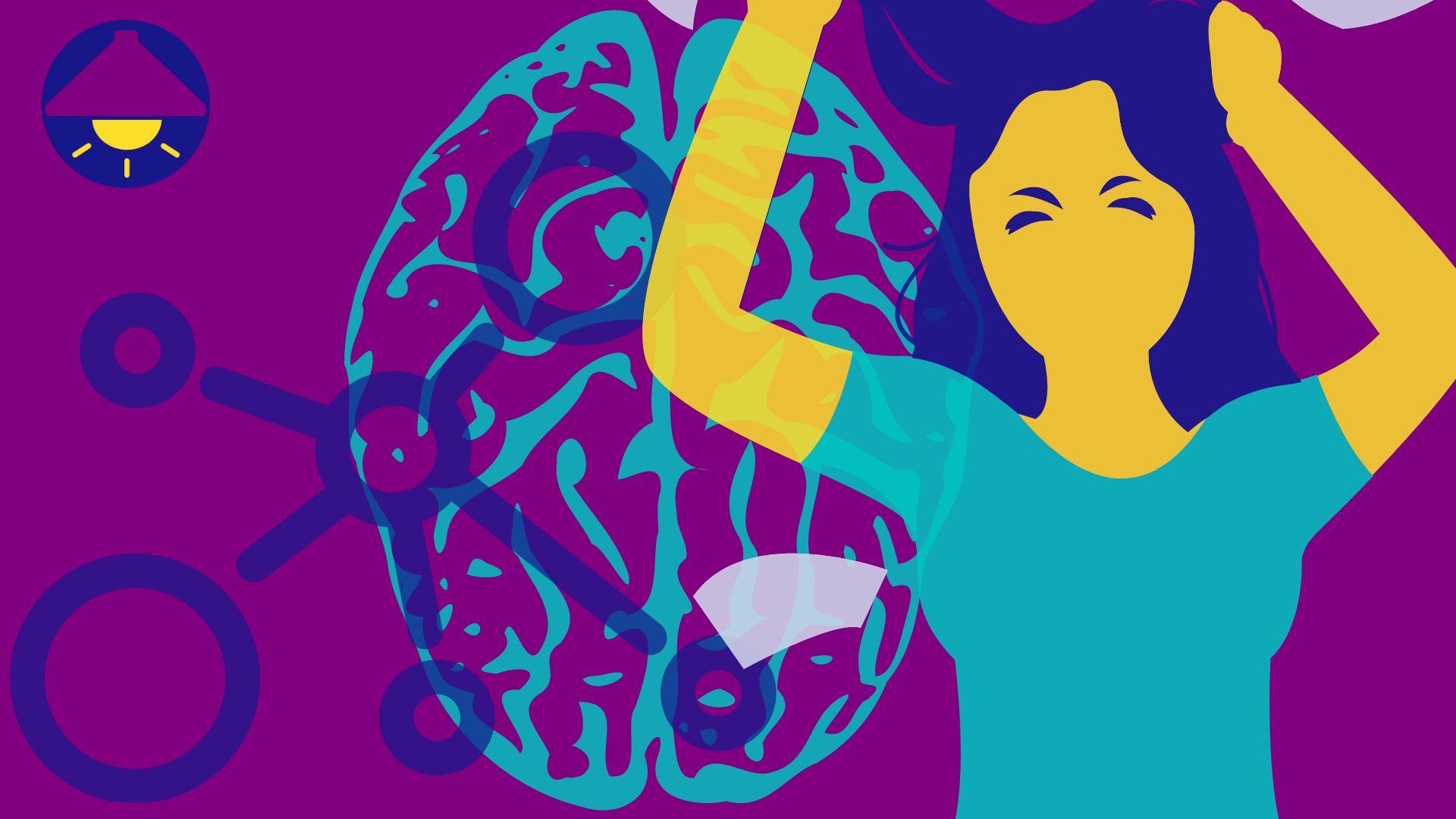
Why and how do we get anxious?
emmi olkkonen has a MSc in genetics and molecular biosciences from the University of Helsinki, currently committed to the exciting task of analyzing Saimaa ringed seal genome data at the Helsinki institute of Life Science. Additional interest in psychology and the genetic contributors to mental health have been aspects of her previous studies and work.
This article is part of the unexpected theme.
edited by tomas, illustration by Ushanandini mohanraj.
The hunter grasped a spear tightly to stop it from slipping from her sweaty hands, as she waited in the silence of the night. She was a strong and persistent hunter, but she knew that alone in the dark, she was vulnerable. Many times, she had thought of leaving, sneaking back to the others, but then she thought of how her brother had smiled three days ago, before leaving camp. Her young, foolish, reckless brother, who had thought that he could take down the beast with nothing but a small hunting knife. She had to do this by herself, for the sake of her brother. What would the others think if she failed? What kind of sister would she be?
She had to wait for the beast, in the place where it had last been seen. In her mind, she had gone through this scenario over and over again. It had kept her awake at night. And now, here she was. Her heart was racing, as she expected to hear something, anything, in the night. A quiet rustling sound from the bushes almost made her jump up. “It is just an animal, not that much different from you”, the hunter told herself and tried to take a few deep breaths but did not manage to calm her heart rate. And the voices that whispered into her ear, painted a picture of all the possible ways that things could go wrong, the voices that told her to run home to the safety of campfires… She could not silence them. And yet, she fought them and stayed.
Far from wild beasts, in our cozy, modern, urbanized world, the same voices still warn us of future threats. For a modern-day student, for example, giving a presentation might cause anxiety, characterized by feelings of fear or worry, increased vigilance and varying physical symptoms. A presentation is, of course, not a life-threatening situation. However, the possibility of public failure is a terrifying prospect for a social species such as us humans. Few things are as intimidating as being scorned or abandoned by our group. Thus, anxiety prepares us for or leads us to avoid threatening situations, whether the threat is to be publicly humiliated in front of our classmates or to be killed by a predatory animal. Therefore, although it can be agreed upon that anxiety is a very unpleasant emotional and physical state, it is a very necessary one. It is the voice that tells us to go back to the safety of the campfire. If we had no aversion towards danger, Homo sapiens may have gone the way of the dodo.
Extinct birds aside – there is a close, bidirectional relationship between anxiety and stress, and anxiety can be induced by stress. Stress response is triggered by an interplay of both neurological and hormonal mechanisms. These include the activation of the sympathetic nervous system and the hypotalamic-pituitary-adrenal axis (HPA axis). The sympathetic nervous system controls organs such as the heart, and it triggers the fight or flight response through the secretion of a stress hormone, adrenalin, from the adrenal gland. The HPA axis, on the other hand, drives stress response through a pathway which leads to the secretion of a hormone called cortisol from the adrenal cortex. These systems affect the hunter, when she experiences physical signs of stress, such as increased heart rate and secretion of sweat in the palms of her hands.
However, anxiety goes beyond acute stress response. For example, the hunter had already started planning the encounter days ago, and it had been a constant worry at the back of her mind ever since. A central feature of anxiety comes into play here: the anticipation of a potential, future threat. This is also one of the features that makes anxiety a complex emotional state and separates it from other defensive emotions, such as plain fear, which is usually caused by a more imminent, concrete threat. Nevertheless, fear usually goes hand in hand with anxiety, and the neural substrates responsible for anxiety and fear partially overlap. Namely, both the medial part of the prefrontal cortex of the brain, which is involved in planning, emotional regulation and stress response modulation, as well as the amygdala, which is responsible for fear learning, have been shown to play a role in anxiety.
Defensive emotions, such as fear, tend to generalize from one situation or stimulus to another. As an example: if the hunter of the beginning ended up in a threatening situation with a wild animal in that particular spot, alone at night, being alone in a similar place in the dark later on might frighten her and make her anxious. Hence, the emotional response would have generalized from a threatening situation to one that resembles it. It makes sense since a similar situation might provide a setting for a similar threat. However, overgeneralization of fear and anxiety to a large proportion of non-threatening situations of daily life (for example, if the hunter got severely anxious anytime she had to go outside alone during daytime) is a key feature of many anxiety disorders, such as the generalized anxiety disorder. Other anxiety disorders include panic disorder and specific phobias.
“What causes anxiety disorders?” one might ask. There is no simple answer to this question, since these disorders are complex in nature. Susceptibility to complex diseases can be affected by a multitude of genetic and environmental factors, personal experiences and interactions between the above. However, dysregulation, such as increased activation of the HPA axis has been reported in anxiety disorders, and early life stressful events have been found to be a risk factor for these disorders. Additionally, several structural and functional changes in the brain have been associated with generalized anxiety disorder. These changes include larger volumes of amygdala and dorsomedial prefrontal cortex in females. Lower white matter volume in the dorsolateral prefrontal cortex has also been associated with general anxiety disorder. * When it comes to functional changes in the brain, abnormal activity in regions such as the amygdala and several areas of the prefrontal cortex have been associated with generalized anxiety disorder.
In conclusion, anxiety is an essential adaptive response, since it urges us to stay out of harm’s way and prepares us for future threats. Had the hunter taken the potential encounter lightly, she might have been less alert, or not as well prepared in the threatening situation. Anxiety is a complicated emotional state, and as demonstrated by what the hunter went through, it has elements of stress and fear. Anxiety is also a complicated state biologically, since it is caused by an interplay of several brain areas, such as the medial prefrontal cortex and the amygdala. Additionally, anxiety is closely linked to stress response mechanisms driven by the sympathetic nervous system and the HPA axis. Although this fine-tuned system is useful for our survival, sometimes anxiety becomes prolonged and disproportionate to the threats present. In this case, this adaptive response has become pathological, and a diagnosis of an anxiety disorder can be given. Sometimes our hunter brains have not yet adapted to our modern world.
* White matter is formed by the myelin sheaths around the axon spines of neurons, and myelin speeds up the electrical impulses in the neurons. Therefore, lower volume of white matter affects brain function.
references
1) Babaev, O., Piletti Chatain, C., and Krueger-Burg, D. (2018). Inhibition in the amygdala anxiety circuitry. Exp Mol Med 50, 1-16.
2) Bateson, M., Brilot, B., and Nettle, D. (2011). Anxiety: an evolutionary approach. Can J Psychiatry 56, 707-715.
3) Daviu, N., Bruchas, M.R., Moghaddam, B., Sandi, C., and Beyeler, A. (2019). Neurobiological links between stress and anxiety. Neurobiol Stress 11, 100191. 10.1016/j.ynstr.2019.100191.
4) Dunsmoor, J.E., and Paz, R. (2015). Fear Generalization and Anxiety: Behavioral and Neural Mechanisms. Biol Psychiatry 78, 336-343.
5) Faravelli, C., Lo Sauro, C., Godini, L., Lelli, L., Benni, L., Pietrini, F., Lazzeretti, L., Talamba, G.A., Fioravanti, G., and Ricca, V. (2012). Childhood stressful events, HPA axis and anxiety disorders. World J Psychiatry 2, 13-25.
6) Maron, E., and Nutt, D. (2017). Biological markers of generalized anxiety disorder. Dialogues Clin Neurosci 19, 147-158.
7) Tsigos, C., and Chrousos, G.P. (2002). Hypothalamic-pituitary-adrenal axis, neuroendocrine factors and stress. J Psychosom Res 53, 865-871.
